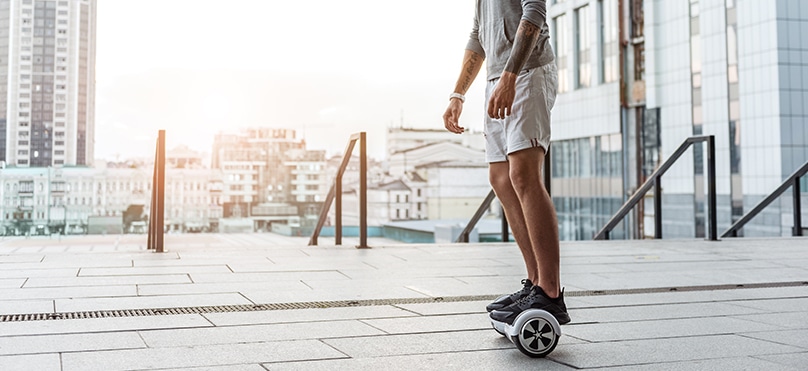Hoverboard Accidents

Hoverboard Accidents and Injuries in NJ
Have you been injured by a dangerous or defective hoverboard?
Most everyone knows someone who has a hoverboard, which is one of the newest and hottest trends on the recreational market right now. These electric, self-balancing skateboards are quickly becoming a popular mode of transportation for teenage and young adult markets. However, as hoverboards gain in popularity, the more frequent are reports about emergency room visits, broken bones, head injuries, exploding devices and appliance fires related to the hoverboards. As with most fads, the more demand for the product, the more vendors jump in to try to manufacture and distribute the product, thus often leading to dangerous products and serious injuries.
Hoverboard vs. Segway
The hoverboard has been compared to the Segway, but this is a dangerous comparison. A Segway uses a balancing mechanism that allows the driver to maneuver the device using a steering column while balancing on the foot board. A hoverboard does not have a balancing mechanism. Instead, it has a weight sensing switch under each foot pad that enables the device to move forward and backward. This limits the range of motion of a hoverboard when compared to a Segway. While the Segway’s safety record is attractive, reports of hoverboard accidents and injuries are quickly piling up.
Another difference between a hoverboard and a Segway is in its charging capacity and safety. While Segway users and manufacturers have not reported problems with overheating during charging, hoverboard consumers have had several reported instances wherein the device has caught fire while charging or has exploded while in use. This overheating problem has been related to the lithium ion batteries and the compatibility of the battery packs and chargers used to power the device.
Unregulated Safety of Foreign Manufacturers
The popularity of hoverboards combined with its affordability has resulted in a great demand for the product. As a result, many unknown foreign manufacturers have begun mass producing imitations of the product. This has caused many safety issues as some of these manufacturers and distributors do not have the same quality and reliability standards as American manufacturers. American companies routinely produce electronic products that meet strict UL certification requirements. Many of the Asian countries now producing hoverboard imitators do not require compatibility with these standards.
The Consumer Product Safety Commission (CPSC) launched an investigation on hoverboard safety in December, 2015. Numerous college campuses, airlines and municipalities have banned the use of hoverboards, pending the review of the CPSC. Many retailers in the United States have responded by promising the public that they will only sell those hoverboard products that comply with American certified safety standards.
Types of Hoverboard Injuries and Guidelines to Safe Usage
While the CPSC investigation will identify safety issues associated with the hoverboard, the safe operation of the device needs to also be addressed. Head injuries, traumatic brain injuries, concussions, contusions, lacerations, broken bones and sprains are the most commonly reported injuries associated with falls from hoverboards. Collisions with motor vehicles are also cause for concern, as many riders take to the streets and public areas to use these devices. Failure to observe and follow the rules of the road can lead to serious and potentially fatal crashes.
Standard safety precautions such as helmets, knee and elbow guards, reflective tape and clothing and proper training on the operation of a hoverboard are essential to avoiding injuries. The age and skill of the hoverboard operator should also be considered. Young children and middle-aged to older adults should proceed with caution when attempting to operate a hoverboard. What starts out as a curiosity with these machines can end up with a trip to the emergency room.
Personal Injury and Product Liability Lawsuits
Consumers have the right to buy products that are safe and free from defects. Manufacturers that fail to produce safe products or neglect to warn the public of inherent dangers associated with their products can be held liable in a personal injury or product liability lawsuit. The laws surrounding personal injury and product liability are complex and require the interpretation of an experienced lawyer. If you are injured in a hoverboard accident, it is wise to consult with an experienced personal injury lawyer or product liability lawyer to discuss your case and determine if you are entitled to compensation.
New Jersey Personal Injury Lawyers at Eichen Crutchlow Zaslow, LLP Represent Clients Injured in Hoverboard Accidents
If you or someone you know has been injured in a hoverboard accident, you may be entitled to compensation. Call the experienced and knowledgeable team of New Jersey personal injury lawyers at Eichen Crutchlow Zaslow, LLP at 732-777-0100 or complete our online contact form to schedule a consultation today. Our offices are conveniently located in Red Bank, Toms River and Edison, New Jersey allowing us to serve clients throughout the state.
